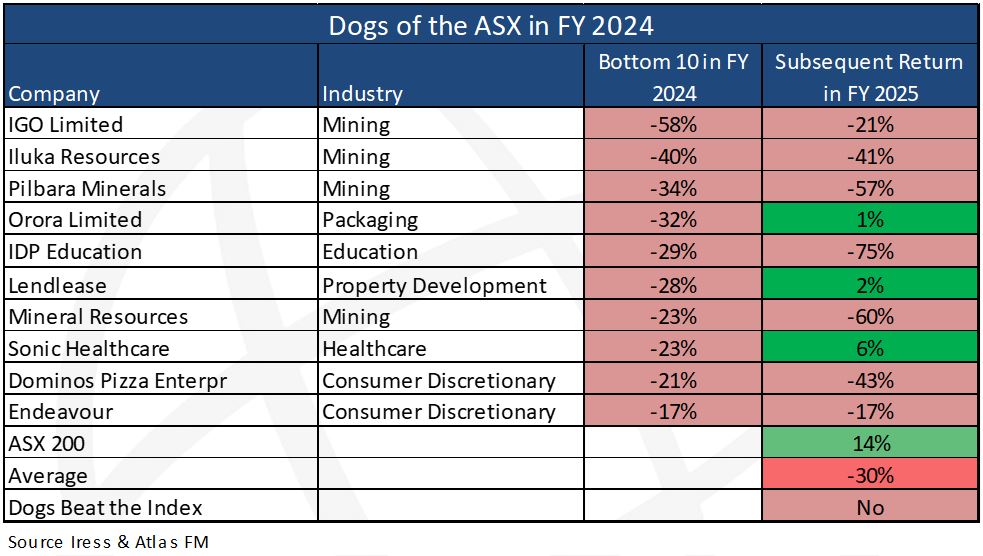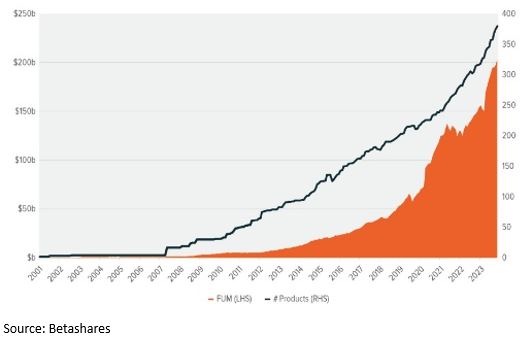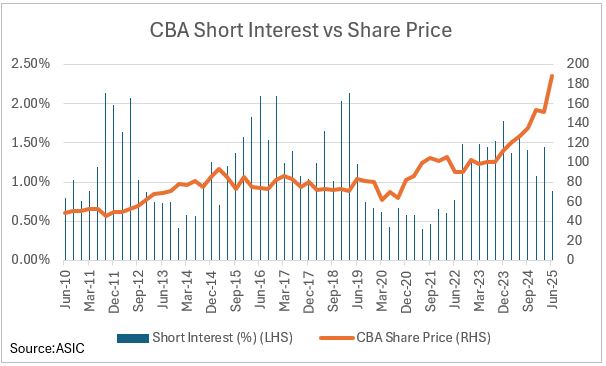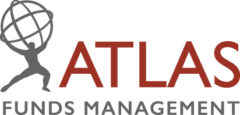Buy Hold Sell: 6 stocks with above-market yields (and 2 from the managers)
Plato’s Peter Gardner and Atlas’ Hugh Dive run the ruler over stocks with above-market yields. They also share a top pick each.
Author: Hugh Dive
Buy Hold Sell: 5 ASX names built for income – Livewire
Dogs of the ASX for the 2025 Financial Year – Livewire
| This article was originally posted on Livewire: Link Here The past year has been quite volatile for investors. August saw a sharp sell-off in global shares after a surprise hike in Japanese interest rates led to an unwind in the Japanese yen “carry trade”. This trade saw hedge funds that had borrowed in cheap yen having to sell high-yielding global shares to repay their loans. Following this, the markets recovered losses and ground higher on the back of the now laughable theory that the Trump presidency would be more business-friendly than the previous administration. From mid-February to April, the ASX collapsed by 14% on the back of very business-unfriendly trade policies from the USA, which seemed to vary by the week. However, the Australian share market was less impacted by vacillating US tariffs than other global markets due to the domestic focus of many of our companies. Indeed, in the last quarter of FY 2025, the ASX 200 was one of the better-performing markets, due to its perceived safe haven, led by the powerhouse CBA (+48%), which saw the most hated rally on the ASX. Despite what feels like a bruising twelve months for investors, the ASX 200 has enjoyed a relatively strong year, up +10% or +13.8% (including dividends). Surprisingly, a very similar return to what investors enjoyed in the 2023 and 2024 financial years. At year-end, many institutional investors cast an eye over the market’s trash to find some treasure to drive portfolio returns in the coming year. Invariably, several bottom-performing stocks will confound market expectations and stage remarkable comebacks! In this piece, we will examine the “Dogs of the ASX” in FY 2025, sifting through the market’s trash to find treasure, and assess how the 2024 Dogs performed. We will also rate Atlas’ picks from 12 months ago. |

| The Theory Behind the Dogs of the Dow Michael O’Higgins popularised a systematic investment strategy of investing in underperforming companies named “Dogs of the Dow” in his 1991 book Beating the Dow. This approach seeks to invest like that of deep value and contrarian investors. O’Higgins advocated buying the ten worst-performing stocks from the Dow Jones Industrial Average (DJIA) over the past 12 months at the beginning of the year, but restricting the selection to those still paying a dividend. Restricting the investment universe to a large capitalisation index, such as the DJIA or ASX Top 100, improves the unloved company’s chances of recovery in the following year. Larger companies are more likely to have the financial strength and assets to sell, as well as an understanding of capital providers (such as existing shareholders and banks) that can provide additional capital to allow the company to recover from corporate missteps or unfriendly economic conditions. For example, over the past year, Mineral Resources bought some breathing room by selling its oil and gas leases to Gina Reinhart for $1.1 billion. Furthermore, larger companies tend to have more options when it comes to lenders, with the same embattled resource company having the majority of its debt on “covenant lite” fixed-rate US bonds. A smaller company is more likely to have its debt held by domestic banks in short-dated facilities, with local banks being more likely to move quickly to recover a doubtful debt, which can have adverse consequences for equity holders. Retail Investors Have an Advantage One of the reasons this strategy persists is that institutional fund managers often report their portfolios’ contents to asset consultants as part of their annual reviews. This process incentivises fund managers to sell the “dogs” in their portfolio towards the end of the year as part of “window dressing” their portfolio before being evaluated. Institutional fund manager selling of underperformers is especially prevalent in December and June of every year. The past year unusually did not provide any great examples of Dogs staging great recoveries, but in July 2022 a fund manager would have been having to vigorously defend why they owned Xero in their portfolio after had fallen -19% in the previous year (Xero’s share price rose +55% in the next 12 months). Similarly, in July 2023, owning contractor Downer EDI would have been a bold move after falling victim to accounting irregularities (gained +16% in FY 2024). Retail investors can afford to take a longer-term view on the investment merits of any company that may have hit a speed bump, as they are not swayed by asset consultants questioning short-term underperformance. Additionally, many underperformers see tax-loss selling around the financial year’s end, further depressing share prices in June. Often, the share prices of these underperformers rebound in the new financial year when this tax loss selling finishes and investors repurchase their shares. This is likely to be a bigger factor in 2025, with many investors looking to offset often very large capital gains realised by trimming CBA by selling poor performers from the past year. Dogs of the ASX in 2025 Over the past year, the Dogs from 2024 fell 30% and underperformed the ASX 200, marking the largest underperformance of the Dogs Portfolio since Atlas began analysing the series in 2011. Notably, in 2025, the “Dogs” contained no significant outperformers. |

| From the table above, not one of the ten “dogs” of 2024 outperformed the index; this is the first time this has happened since 2010. The pain continued for lithium miners, including Pilbara Minerals, IGO, and Mineral Resources, following further declines in commodity prices and mine shutdowns. Mineral sands producer Iluka faced the challenge of rising costs, production issues and weaker Chinese demand for zircon. The pain continued in FY25 for former high flyers and favoured “growth” stocks, Domino’s Pizza and IDP Education. Domino’s announced that it was closing stores in Japan, Europe, and Australia. However, the broader market was concerned about declining same-store sales, as consumers focused on healthier options rather than just price and portion size. IDP Education had another rough year, with its share price now down 90% from its 2021 peak. University student placements and associated English-language testing volumes were impacted by restrictive international student policies in their key markets, including Australia, Canada, and the USA. The company is in a challenging position, as it has limited influence over government regulations regarding immigration policy. Endeavour has continued to underperform in 2025 due to slower retail alcohol sales and tighter regulations around its gaming machines, a high-margin hotel business segment. Our Picks From July 2024?? When making our picks twelve months ago as to which of the Dogs from FY 2024 would rebound over the coming year, Atlas’ class mark would be a “pass on a technicality”, probably a C+. We declined to pick a recovery in the lithium price due to the lack of owning a crystal ball. Similarly, Atlas did not select Domino’s to recover due to our lack of familiarity with the pizza markets in Japan, France, and Taiwan, as well as the associated costs of store closures. Similarly, in July 2024, we were cautious towards IDP Education after the Australian government increased international visa fees by 125%. However, we did not identify any further adverse factors impacting the stock, such as UK student visa restrictions and the Trump administration’s attempt to block Harvard from enrolling international students. In July 2024, Atlas picked Lend Lease (+2%) and Sonic Healthcare (+6%) to stage recoveries in FY 2025. Although this technically occurred, and these two were the best-performing Dogs of the ASX in FY 2024, both of their share price gains underperformed the ASX 200’s return. What Does the Class of 2025 Look Like? Looking through the list of 2025 underperformers, there are both some new and old faces on the list. IDP Education, Mineral Resources, Pilbara and IGO back up from FY2024, much to the chagrin of their shareholders. The key themes in the list of Dogs for the financial year 2025 are: 1. Commodity Prices – IGO, Pilbara Minerals, Fortescue, Whitehaven and Mineral Resources 2. Weaker consumer demand for non-essentials – Flight Centre, Reece and Treasury Wine 3. Adverse Government Regulation – IDP Education and Treasury Wine |

| Our Picks For FY 2026 In almost every year (except for last year), three or four companies in the Dogs of the ASX list will significantly outperform the market over the following year. Recency bias leads most investors to put too much emphasis on recent negative news and extrapolate this into the future, creating an investment case that the current unfavourable market conditions or poor management decisions will continue indefinitely. As always in selecting a share price recovery candidate for the next year, we generally look at companies whose current woes are company-specific rather than caused by factors outside the control of their management team, such as falling commodity prices or adverse government policies. Atlas’s picks for a recovery in the next 12 months are Mineral Resources and Whitehaven Coal. While both companies have been exposed to falling commodity prices that are beyond management’s control, both companies also possess near-term catalysts within management’s control that should see their share prices re-rate. The completion of the resurfacing of Mineral Resources Onslow iron ore haulage road is scheduled for September 2025. This will enable the company to move towards achieving its nameplate capacity of 35 million tonnes and start reducing its debt load. While management cannot influence global lithium prices, they can resurface a road. We see that FY2026 looks brighter for Whitehaven Coal after management has made a number of good moves over the past year. In March, the company sold down 30% of the recently acquired Blackwater metallurgical coal mine to customers Nippon Steel and JFE Steel, and has taken costs out of the formerly BHP-owned asset. A move that leaves the company effectively debt-free and paves the way for Whitehaven to lift dividends in August. Additionally, Whitehaven have recently started on an on-market share buy-back. |
The Most Hated Rally on the ASX
In the world of Australian equities, few names carry the gravitas of Commonwealth Bank of Australia (CBA). It’s the blue-chip darling of retirees, fund managers, and index-huggers alike. However, most fund managers are underweight the $300 billion banking behemoth, especially those that followed calls early last year by the sell-side analysts to sell the banks. As the share price continues its gravity-defying ascent, recently notching a record high of over $191, investors are left wondering: is this a triumph of fundamentals, or are we witnessing the makings of another valuation bubble?
In this week’s piece, Atlas tries to unpack the forces at play, the implications for the broader market, and what this means for investors navigating a market increasingly shaped by passive flows and sentiment over substance.
Why do Fund Managers Hate This Rally
The hatred of this rally in CBA’s share price among fund managers is due to selling down their positions in the bank over the past 18 months, which has then caused underperformance against the benchmark ASX200 index. When a smaller company experiences spectacular share price growth, it will have a minimal impact on the ASX 200; however, CBA has delivered a total return of 55% over the past 12 months, far ahead of the benchmark return of 13%. With an average index weight of 10% over the last 12 months, if fund managers had not owned CBA at all, they would have to find over 3.5% of fund performance elsewhere to match the index performance. Not an easy task.
As a disclaimer, Atlas’ stance is now one of strong dislike not hatred towards the CBA rally, after being slow to reduce our holdings. The Atlas Core Australian Equity Portfolio has sold three times over the past six months to move to an underweight in CBA: in December ($156), April ($167), and June ($181). Each time prematurely patting ourselves on the back thinking that we had picked the share price peak.
Price Earnings Expansion Rally
The recent rally in the share price of CBA has not been accompanied by higher earnings, but rather the same earnings becoming more expensive for investors to purchase. As you can see from the table below, CBA’s price-to-earnings multiple expanded in 2024 and 2025 from its long-term average of 15 times, tracking the move in the share price from $100 to $191.
The bulk of CBA’s profits come from loans made to households and corporates, which, unlike luxury consumer goods like Louis Vuitton handbags or Glenfarclas 25-year-old single malt whisky, have no brand premium attached. Despite extensive advertising, borrowers remain indifferent about which bank to choose for their mortgage funding. Indeed, CBA operates in a domestic banking market with limited credit growth in Australia, selling an identical product to that offered by four other competitors (now including Macquarie), all of which have the same cost of production (capital). By way of comparison, CBA’s competitors (Westpac, ANZ and NAB) trade on a average PE ratio of 15.5 times with a 4.8% yield.
This current rally has seen CBA move into the world’s top ten most valuable banks and become the first developed market bank in history to trade at a multiple greater than 30 times earnings.

Passive Flows Driving the Market
One of the key drivers behind CBA’s meteoric rise has little to do with its earnings or strategy. Instead, it’s the sheer weight of money flowing into passive investment vehicles. As the largest constituent of the ASX 200, CBA receives the lion’s share of every dollar that flows into index-tracking funds, such as Vanguard’s VAS or Betashares’ A200. This creates a self-reinforcing loop: rising prices attract more inflows, which in turn push prices higher. It’s a virtuous cycle—until it isn’t. Currently, CBA comprises 12% of the ASX 200, the highest weighting of a single company in the ASX 200 since News Corp reached 15% during the Tech boom of 2000. BHP also hit 15% in February 2009, although this was more a result of a stable share price in the face of other large companies experiencing meltdowns during the depths of the GFC. Not dissimlar to Steve Bradbury’s performance on the ice in Salt Lake City in 2002!
While CBA current dominance of the ASX 200 is quite significant, there have been more extreme cases in other developed stock markets. I started my career in Canada working for a large Vancouver-based fund manager and unfortunately, that coincided with the “dot.com” boom. During July 2000, telco stock Nortel peaked at 35% of the TSE 300 Composite, with the tech behemoth moving the benchmark index by itself. Now that was a truly hated rally, with many fund managers including the one that I worked for having a 10% position limit on any one stock in the portfolio!

The shorts have already been burned
Shorting the Australian banks has historically ended up as a widow-maker trade. A “Widow-Maker” trade in the hedge fund world is a short-selling of an overvalued asset that may make sense intellectually. Still, the share price continues to rise despite the bearish investment thesis. As it continues to rise, the short seller is forced to post ever-increasing amounts of cash into their margin account, increasing the chance that the fund manager has a heart attack or gets fired.
US and European fund managers have been systematically shorting Australian banks based on the seductive story that they are overvalued compared to their domestic peers. International investors have historically made mistakes by assuming that Australian banks operate in the same regulatory environment as their domestic banks. The basis for their thesis is that four banks from a small backwater in the financial world have little business, being amongst the largest in the world.
Short interest in CBA has been relatively low in recent years, peaking in December 2023 at 1.8%, and currently stands at 0.88%. CBA’s rising share price would have seen continual margin calls being issued to short sellers, until the short seller gives up and closes out the position by buying back the CBA shares on the market.
Whilst this 0.9% decrease in the outstanding stock being sold short may seem insignificant, if the average purchase price for hedge funds covering their short positions were $140, it would equate to over $2.1 billion in hedge fund managers buying CBA stock with gritted teeth.

This has all been achieved without CBA turning on the buyback machine
The last time CBA bought back any shares from its $1 billion on-market buyback was on November 2024 at $152 per share, leaving $700 million of buyback outstanding. CBA management is incentivised to return excess capital to shareholders as bank management teams are awarded bonuses based on their return on equity (ROE). The ROE increases as the bank buys back shares, reducing the equity divisor on its return. In CBA’s February result, the bank announced that it had a capital ratio of 12.2% well above the minimum capital ratio set by APRA of 11%. CBA’s management deciding not to repurchase their own shares, despite having financial incentives to do so, indicates what company “insiders” think of the bank’s share price.
Why would global managers be buying CBA?
The terrible historical offshore expansions conducted by the other major Australian banks, which saw billions of shareholders’ value eroded, have led CBA to sensibly restrict its operations to the Australian domestic banking market. Whilst this is a limited market opportunity, it does create a lot more certainty and consistent and predictable earnings that are only exposed to a small subsector of the global economy. So, in a world of rising geopolitical risk and economic uncertainty, investors often gravitate toward quality and stability. CBA’s conservative balance sheet, strong capital buffers, and predictable dividend stream make it a safe haven for global investors. Indeed, earlier in June, a Texas-based investment manager, Fisher Investments, revealed that they had spent $1 billion buying CBA shares over the previous two weeks, at a level we estimate to be around $170 per share.
Our take:
While Commonwealth Bank has long been the “Steven Bradbury” of Australian banking—winning by avoiding the missteps of its peers—its current valuation appears to be running well ahead of fundamentals. At over 30x forward earnings and a dividend yield below the broader market, investors are now paying growth-stock multiples for what is, in essence, a mature, low-growth stock with a highly leveraged balance sheet and limited to no international expansion prospects.
Historically, banks like CBA have traded at a premium due to their robust balance sheets and consistent dividend payments. But today’s premium feels more like a product of passive fund flows, index weightings, and a scarcity of large-cap alternatives than a reflection of earnings growth. Real dividends, when adjusted for inflation, remain below 2015 levels, yet the share price has nearly doubled since then.
As we’ve seen in past decades—from Japanese megabanks in the ’90s to US giants pre-GFC—being the world’s most valuable bank is often a prelude to underperformance. While CBA remains a high-quality franchise, the current price implies perfection. And in markets, perfection rarely lasts, and there will be many fund managers in June 2025 praying for the bank’s share price to correct to more rational levels.


